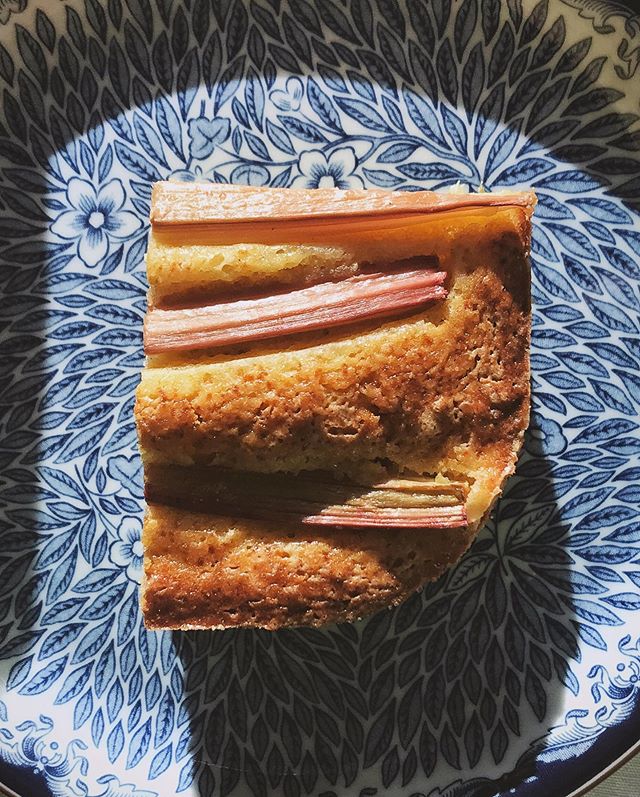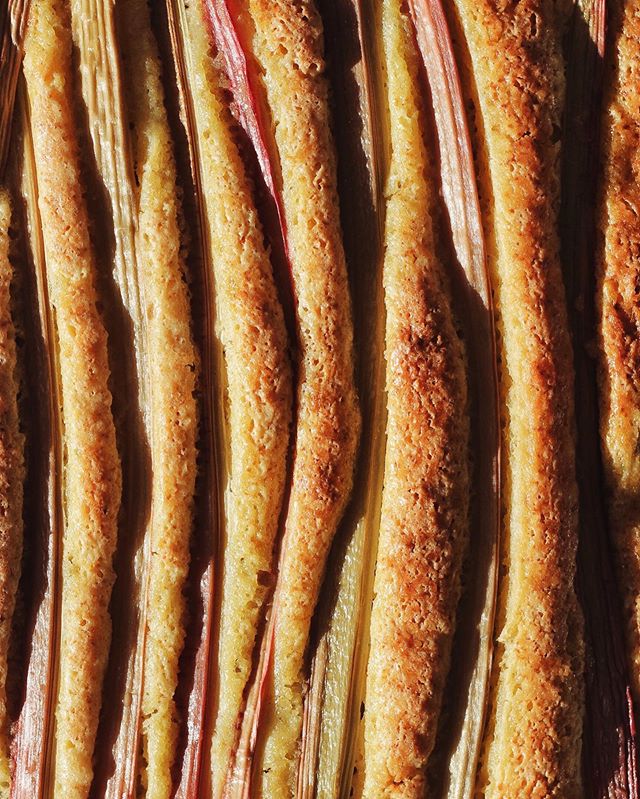Every spring I get a sudden hankering for rhubarb, get excited when I spot some in a shop or market, buy one or two bunches of pretty pink stems, eagerly bring them home… and then proceed to wonder what exactly to do with them. The answer is often cake — and this year was no different.
You don’t have to be über-precise when it comes to home baking (the same cannot be easily said for pastry-making), but I do find it useful to follow a well-tested recipe when trying something new. On this particular day, I not only had rhubarb, but also a pretty big tub of yogurt sitting in the fridge and begging to be used. After some Googling, I came across a recipe that looked good enough to emulate. Here’s a written attempt at describing what I did (but you can also watch me in action here and here).
yogurt & olive oil rhubarb cake with cardamom & orange
This cake is essentially a pound cake, so it will travel easily and stay nice and moist if kept loosely covered at room temperature for up to 4 days (I’ve tried and tested this multiple times, it really does make for a great picnic dessert — even at 4 days post-bake). It also makes an excellent gift!
what you’ll need
EQUIPMENT / TOOLS
- a 33x25cm (13-by-10-inch) or 23x23cm (9-by-9-inch) cake pan, or equivalent baking tin
- 1 sharp knife and cutting board for the rhubarb
- 1 large mixing bowl for combining all the ingredients together
- 1 medium bowl for tossing the rhubarb pieces in flour
- 1 scale or measuring cup for measuring dry and wet ingredients
- 1 whisk or fork for thorough mixing
- a microplane, box grater or other zester with fine holes for the orange zest and/or fresh ginger
- 1 rubber spatula for scraping and stirring
- 1 regular or measuring teaspoon for portioning out smaller amounts
INGREDIENTS
- butter ~1 Tbsp just enough for greasing your pan or tin
- fresh rhubarb 2 long medium stalks (or equivalent) whatever you have access to will do the trick!
- plain flour 180g (1 CUP), + 1 Tbsp plus a bit extra for dusting the pan*
- chickpea (gram) flour 60g if you don’t have any, feel free to use more plain flour here instead — I find gram flour keeps the cake nicely sturdy and prevents crumbliness
- baking powder 2 tsp (10mL or ~5g)
- ground cardamom 1 tsp (5mL or ~2.5g)
- powdered ginger 1 tsp (5mL or ~2.5g) or whole ginger 2 tsp (10mL or ~5g) fresh or frozen, and finely minced/grated with a microplane
- fine salt ½ tsp (2.5mL or ~1.25g)
- plain Greek yogurt 230g (1 CUP) full fat works best
- white granulated sugar 150-200g (¾-1 CUP) + a bit extra for sprinkling on top at the end* use less if you like things less sweet, more if you prefer your cake to be on the sweeter side
- eggs 3 large ones
- extra virgin olive oil 105 g (½ CUP or 120mL)
- orange zest from 1 orange this yields around 2-3 Tbsp handy info if, like me, you keep citrus zests in small jars in your freezer
- vanilla 1 tsp you can use vanilla extract, vanilla sugar, or ground vanilla
* tip: you could actually sprinkle your buttered pan with sugar instead of flour, for slightly crisper edges — I use both methods regularly, just depends on what I’m in the mood for!
let’s bake a rhubarb cake !
METHOD
- Place a rack in the middle of your oven, and set the temperature to 180°C / 350°F (160°C Fan or Gas 4).
- Prepare your baking tin by smearing butter onto its bottom and sides. Feel free to use your fingers to get good coverage. Add a dusting of flour (or sugar, see asterisk* above), and shake and rotate the tin so the flour clings to the butter evenly.
- Cut the two rhubarb stalks so that the pinkest ends are just long enough to fit into your baking pan, or roughly in half across their middle, so as to produce 4 shorter stalks in total. Take the greenest halves, and cut them into 1.5cm or ½ inch-wide chunks. Put those pieces in a medium bowl, toss them with 1 tablespoon of flour, and set aside (this will help stop the rhubarb from sinking to the bottom of the batter while baking). Take the pinkest halves and cut them down the middle lengthwise, so as to make a thinner stem. Repeat once more to arrive at 8 narrow stems in total. Set aside.
- Measure out 240g or 1½ CUPs of flour into your large mixing bowl. Add in 2 teaspoons of baking powder, and 1 tsp each of ground cardamom and ginger (only if using powdered). Whisk everything together to get a homogeneous mix. Using a spatula, scooch the flour mixture to the outsides of the bowl to create a well in the centre your dry ingredients.
- Measure out 200g or 1 CUP of sugar (or as little as 150g or ¾ CUP, if like me you like things less sweet) into the well. Then add in the 230g or 1 CUP of yogurt, the 3 eggs, the 105g or ½ CUP of olive oil, the 2-3 Tbsp orange zest, 2 tsp grated ginger (only if using fresh or frozen) and 1 tsp vanilla.
- Starting in the middle of the well, whisk the wet ingredients together to make sure they are well mixed. Then slowly whisk outwards to incorporate the dry ingredients into the wet, until just combined. Add in your floured rhubarb pieces and gently mix again, this time folding the batter with the spatula.
- Pour the batter into your prepared pan and smooth the top with the spatula so that the surface is level. Use the rhubarb stems you sliced earlier to decorate the top to your liking (you could slice them again into smaller sticks, if you like) — I chose to line mine up evenly across the top of the cake. Finish with a very light sprinkling of sugar to help the top get nice and golden.
- Set the cake in the oven and bake it until the top is golden and a knife inserted into its centre of the cake comes out clean. This should take 45-50 minutes to 1 hour, depending on your oven and baking tin.
If you can resist it, I recommend letting the cake cool at least 15 minutes before diving in.
thoughts on substitutions
This cake is great as such, but I’d hate for the dislike or intolerance of a certain ingredient to prevent you from enjoying it.
For the spices, you could probably double or halve (or even omit) the quantities of cardamom, orange zest and ginger according to what you want or have. If you’re looking to give the aromatics a twist (or don’t have all the ingredients), why not try lemon zest in place of the orange, or almond extract instead of the cardamom and ginger?
This cake would probably work well later in the year with stone fruit instead of rhubarb (think peaches, plums or apricots) in summer, and with apples and pears in the fall (cinnamon and nutmeg would be interesting spices to use with these fruit). I also have a hunch that swapping out a bit of the flour for almond or other nut flours such as hazelnut would turn out nicely, too.
Lastly, if you don’t consume dairy, I’ve made this cake with Greek “oatgurt” before and it turned out really great! If you want to make the recipe fully plant-based, I think using a butter substitute for the tin and ground flax seeds + water in place of the eggs in the batter (as well as potentially using only gram flour) could work quite well — but I have yet to try it myself, so you’ve been warned.
Definitely go for it if you’re feeling adventurous!
recipe originally posted on September 8 2020, updated June 15 2022




